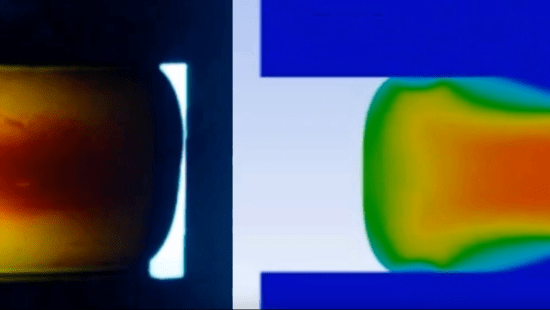
Reprocessable High Performance Thermosets
The permanent covalent crosslinks that give thermoset polymers like polyurethanes, epoxies, silicones, and natural rubbers their outstanding mechanical properties and solvent resistance also make them un-recyclable. They cannot be reshaped or melt-reprocessed the way a thermoplastic can. A new class of materials, covalent adaptable networks (CANs), offer a potential solution, and have become a central focus of the group in recent years. Our current research revolves around the disulfide bond, which can dynamically break and reform with other partners at high temperatures, while maintaining the strength and stability of a covalent bond under operational conditions. Thus, a thermoset with disulfide crosslinks can flow like a thermoplastic at high temperatures, unlocking pathways to recyclability. As a polymer mechanics group, we are particularly interested in the unique behavior of disulfide bonds under high mechanical stress: the sacrificial cleavage of these bonds not only serves as an energy dissipation mechanism, making the material tougher, but also as a visual early warning before failure, since aromatic disulfide bonds produce vibrant colors when broken!
Selected Publications
Lewis, Broderick, Joseph M. Dennis, and Kenneth R. Shull, “Effects of Dynamic Disulfide Bonds on Mechanical Behavior in Glassy Epoxy Thermosets”, ACS Applied Polymer Materials 2023 5 (4), 2583-2595.
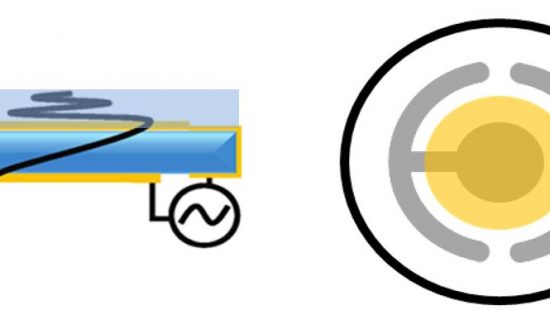
The Quartz Crystal Microbalance
One central expertise of the Shull group is in using the quartz crystal microbalance (QCM) as a high-frequency (15 Mhz) rheometer. While the QCM is largely known a mass balance for detection of small molecules, we have developed its capability to extract mechanical properties from thin films (~1-5 microns) that are otherwise difficult to access with traditional methods such as tensile tests. The fixed frequency rheometric mode of the QCM allows high precision and resolution for monitoring changes in mass associated with changes in mechanical properties. The versatility of the QCM as a rheometer has significantly expanded the polymer scientist’s characterization toolbox, and our group is at the forefront of introducing this technique to the polymer science community. Learn more in our QCM dedicated tab!
Selected Publications
Kazi Sadman, Clinton G. Wiener, R. A. Weiss, Christopher C. White, Kenneth R Shull, and Bryan D. Vogt “Quantitative Rheometry of Thin Soft Materials using the Quartz Crystal Microbalance with Dissipation (QCM-D)”, Anal. Chem. 2018, 90(6), 4079–4088
Martin, E. J., Sadman, K., & Shull, K. R. Anodic Electrodeposition of a Cationic Polyelectrolyte in the Presence of Multivalent Anions. Langmuir 32, 7747–7756 (2016).
Yeh, C. Joshua, Matt Dowland, Randall G. Schmidt, and Kenneth R. Shull. “Fracture and thermal aging of resin‐filled silicone elastomers.” Journal of Polymer Science Part B: Polymer Physics 54, no. 2 (2016): 263-273.
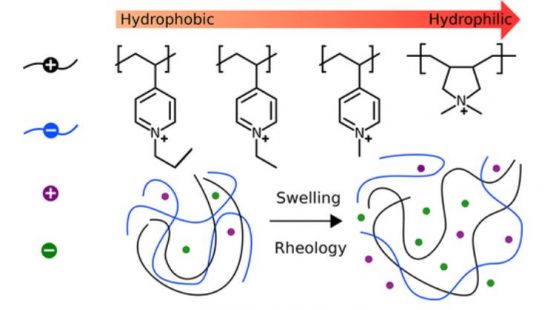
Charged Complexes & Self-assembly
A significant focus of our group is in studying non-covalently self-assembling soft materials. Many of our efforts have been to enhance the understanding of how structure controls function for hydrogels and charged complexes. We are interested in synthesis and processing methodologies to realize new physical phenomenon, such as thermo-thickening. We embrace simplicity and elegance in our materials systems which still provides deep fundamental insights. Much of our recent work has been on polyelectrolyte complexes which are materials composed of oppositely charged polymers. The complexion of polycations and polyanions has been leveraged over the past three decades in applications such as water filtration, biomaterials, and coatings. A fundamental understanding of the phase behavior and role of non-covalent interactions these systems has yet to be fully realized. In our group, we use a variety of mechanical techniques to understand factors such as hydrophobicity, salt identity, and ion-specific effects.
Selected Publications
Kazi Sadman. Qifeng Wang, Yaoyao Chen, Bavand Keshavarz, Zhang Jiang, Kenneth R. Shull, “Influence of Hydrophobicity on Polyelectrolyte Complexation”, Macromolecules, 50(23), 9417-9426 (2017)
Ha-Kyung Kwon, Victor A. Pryamitsyn, Jos W. Zwanikken, Kenneth R. Shull, Monica Olvera de la Cruz “Solubility and interfacial segregation of salts in ternary polyelectrolyte blends“, Soft Matter, 13, 4830-4840, cover article (2017)
Henderson, Kevin J., Tian C. Zhou, Kathryn J. Otim, and Kenneth R. Shull. “Ionically Cross-Linked Triblock Copolymer Hydrogels with High Strength.” Macromolecules 43, no. 14 (2010): 6193-6201.
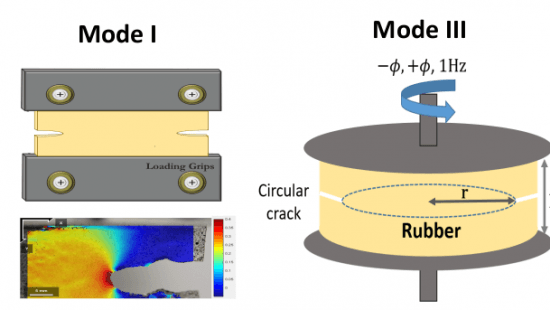
Advanced Mechanics of Materials
Advanced mechanical testing methods are used to test materials (e.g. rubbers, gels, and polymer composites), simulating the loading states in real applications. These advanced techniques include multi-axial loading capability, traditional rheology, long term fatigue experiments, advanced indentation tests, and biaxial creep tests, with temperature controlling capability. The combination of optical methods (digital image correlation and optical microscope), with mechanical tests, allows us to probe the flow, deformation, fracture, and fatigue in a wider range of materials from very soft gels to stiff composites.
Selected Publications
Pavan V. Kolluru, Matthew D. Eaton, David W. Collinson, Xu Cheng, David E. Delgado, Kenneth R. Shull, and L. Catherine Brinson “AFM-based Dynamic Scanning Indentation (DSI) Method for Fast, High-resolution Spatial Mapping of Local Viscoelastic Properties in Soft Materials”, Macromolecules, 2018, 51(21), 8964-8978
Yaoyao Chen, and Kenneth R Shull, “High-Toughness Polycation Cross-Linked Triblock Copolymer Hydrogels“, Macromolecules, 50(9), 3637-3646 (2017)
Shull, Kenneth R. “Contact Mechanics and the Adhesion of Soft Solids.” Materials Science and Engineering: R: Reports 36, no. 1 (2002): 1-45.
Crosby, A. J., K. R. Shull, Y. Y. Lin, and C-Y. Hui. “Rheological Properties and Adhesive Failure of Thin Viscoelastic Layers.” Journal of Rheology (1978-present) 46, no. 1 (2002): 273-294.
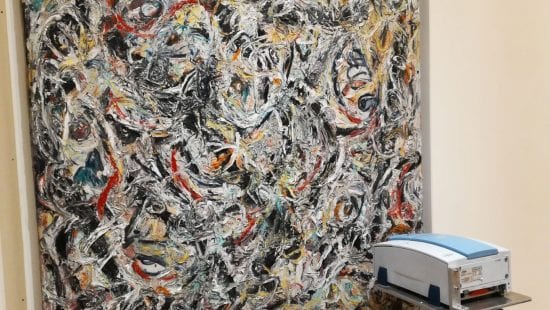
Art Conservation
An ongoing thrust of our group is to look at polymer systems in cultural heritage. Currently this involves studying the properties of Linseed oil and other organic molecules in oil paintings. We are interested both in the properties of these materials as a function of time, temperature, UV and visible light exposure as well as interactions with other common elements of oil paints such as inorganic pigments. One project involves the study of the stability of titanium dioxide white pigments in early 20th century works. This project is part of an international collaboration with the University of Perugia in Perugia Italy. This project combines the organic knowledge and characterization techniques central to the Shull group with inorganic and non-invasive techniques from our collaborators in an attempt to create a clear picture of the true environment of an oil painting as a function of common environmental factors. A second project involves collaboration with the University of Amsterdam to study the properties of linseed oil in attempt to isolate each element of the complex system that is an oil paint.
Selected Publications
Sturdy, L. F., Yee, A., Casadio, F. & Shull, K. R. Quantitative characterization of alkyd cure kinetics with the quartz crystal microbalance. Polymer 103, 387–396 (2016).
Lindsay Hardt Oakley, Francesca Casadio, Kenneth R Shull, and Linda J. Broadbelt “Theoretical study of epoxidation reactions relevant to hydrocarbon oxidation“, Ind. Eng. Chem. Res., 56(26), 7454–7461 (2017)
Lindsay Hardt Oakley, Francesca Casadio, Kenneth R Shull, and Linda J. Broadbelt “An Examination of Mechanisms for the Formation of Volatile Aldehydes from the Oxidation of Oil-based Systems”, Ind. Eng. Chem. Res., 57(1), 139-149 (2018)
